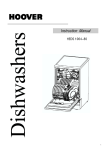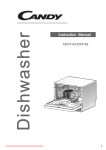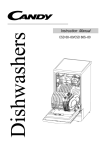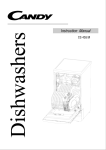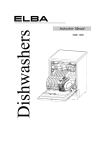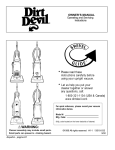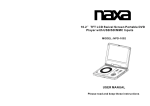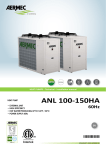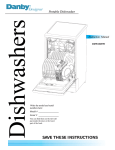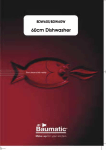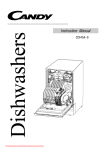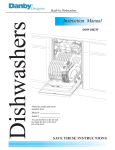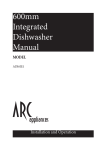Download DISHWASHER INSTRUCTION MANUAL
Transcript
DISHWASHER INSTRUCTION MANUAL ..................1 This manual contains sections of Safety Instructions,Operating Instructions, Installation Instructions and Troubleshooting Tips etc. Carefully reading it before using the dishwasher will help you to use and maintain the dishwasher properly. To review the section on Troubleshooting Tips will help you to solve some common problems by yourself and not need to ask for the help of professional technicians. Control Panel . . . . . . . . . . . . . . . . . . . . . . . . 2 Dishwasher Features . . . . . . . . . . . . . . . . . 2 Wash Cycle Table . . . . . . . . . . . . . . . . . . . . 3 Water Softener . . . . . . . . . . . . . . . . . . . . . . 4 Detergent . . . . . . . . . . . . . . . . . . . . . . . . . . . 5 Rinse Aid . . . . . . . . . . . . . . . . . . . . . . . . . 5, 6 Loading the Dishwasher Rack . . . . . . . . 6,7 Turning On the Appliance . . . . . . . . . . . . . . 7 Filtering System . . . . . . . . . . . . . . . . . . . . . 8 Caring for the Dishwasher . . . . . . . . . . . . . 9 About Electricity connection . . . . . . . . . . 10 Water Connection . . . . . . . . . . . . . . . . . . . 11 Dimensions . . . . . . . . . . . . . . . . . . . . . . . . 11 Before calling for service. . . . . . . . . . 12,13 Guarantee...........................................14 The manufacturer, following a policy of constant development and up-dating of the product, may make modifications without giving prior notice. This appliance must be grounded. In the event of a malfunction or breakdown, grounding will reduce the risk of electric shock by providing a path of least resistance of electric current. This appliance is equipped with a cord having an equipment-grounding conductor and a grounding plug. The plug must be plugged into an appropriate outlet that is installed and grounded in accordance with all local codes and ordinances. Do not abuse, sit on, or stand on the door or dish Improper connection of the equipment- grounding conductor can result in a risk of electric shock. Check with a qualified electrician or service representative if you are in doubt whether the appliance is properly grounded. Do not modify the plug provided with the appliance ;If it is not fit for the outlet .have a proper outlet installed by a qualified electrician. Do not operate your dishwasher unless all rack of the dishwasher. enclosure panels are properly in place. Open the door very carefully if the dishwasher is operating, there is a risk of water squirting out. Do not touch the heating element during or immediately after use. Do not place any heavy objects of stand on the door Do not wash plastic items unless they are marked when it is open. The appliance could tip forward. dishwasher safe or the equivalent. For plastic items not so marked, check the manufacturer's recommendations. When loading items to be washed: Use only detergent and rinse additives designed for an automatic dishwasher. Never use soap , laundry detergent, or hand washing detergent in your dishwasher. Keep these products out of children. Keep child away from detergent and rinse aid, keep 1) Locate sharp items so that they are not likely to damage the door seal; 2) Load sharp knives with the handles up to reduce the risk of cut-type injuries. When using your dishwasher, you should prevent plastic item from contacting with heating element. If the supply cord is damaged, it must be replaced child away from the open door of the dishwasher, there could still be some detergent left inside. by the manufacturer or its service agent or a similarly qualified person in order to avoid a hazard. The door should not be left in the open position since this could present a tripping hazards. Please dispose of packing materials properly. During installation, the power supply must not be excessively or dangerously bent or flattened. Use the dishwasher only for its intended function. The appliance is not intended for use by young Young children should be supervised to ensure that Dishwasher detergents are strongly alkaline,they Check that the detergent receptable is empty after children or infirm persons without supervision. can be extremely dangerous if swallowed.Avoid contact with skin and eyes and keep children away from the dishwasher when the door is open. WARNING: Knives and other utensils with sharp points must be loaded in basket with their points down or pl aced in a horizontal position. 1 they do not play with the appliance. completion of the wash cycle. Do not tamper with controls. The appliance is to be connected to the water mains using new hose-sets and that old hose-sets should not be reused. To get the best performance from your dishwasher,read all operating instructions before using it for the first time. 1 2 3 4 6 8 9 7 5 1 Pre-rinse light: come on when pre-rinse. 2 Wash light:come on when wash. 3 Rinse light: come on when rinse. 4 5 6 Start / Reset Button: Press this button to start or stop the dishwasher, the light will come on when starting. 7 Washing Program Selector: Turn the knob clockwise to select wash cycles. Drying light: come on when drying. 8 ON/OFF Button: To turn ON/OFF the power supply. Door Handl e:Pull to open the door. 9 Power Light : come on when the ON/OFF Button is Press e d . 7 1 2 3 8 4 5 9 11 6 12 10 1 2 3 Upper Basket Spray Arms Lower Basket 4 5 6 Water Softener Main Filter Detergent Dispenser 7 8 9 2 Cup Shelf Silverware Basket Coarse Filter 10 11 12 Rinse Aid Dispenser Drain pipe connector Inlet pipe connector For the heaviest soiled loads, such as pots,pans,casserole dishes and dishes that have been sitting with dried food on them for a while. Strong Normal Normal W ash (EN 50242) 1 For normally soiled loads, such as pots , plates,glasses and lightly soiled pans. standard daily cycle. Pre-wash Pre -wash( 50℃) Wash (60 ℃) Rinse (70 ℃) Drying 4/20g Pre-wash Pre -wash Wash (50 ℃) Rinse (65 ℃) Drying 4/20 g Economy For lightly soiled loads,such as plates,glasses,bowls and lightly soiled pans. Pr e-wash Wash (50 ℃) Rinse ( 65 ℃) Dr ying 20 g Rapid A shorter wash for lightly soiled loads that do not need drying. Pre-wash Wash (40 ℃) Rinse ( 65℃) Drying 15 g Soak To rinse dishes that you plan to wash later that day. Pre-wash If you want to change the programmes while the dishwasher is running, carry out the following steps: Please press the start button and last more than three seconds. Turn around the programme knob to select the desired programme. Draw out the lower and upper basket, load the dishes and push them back. It is commended that loading the lower basket first, then the upper one. 1 2 3 2 With a little force to ensure the door is properly closed. NOTE: A click could be heard when the door is closed perfectly. the plug into the socket. 3 Insert The power supply is 230VAC 50HZ, the specification of the socket is 10A 250VAC. Press the Start button to start washing. NOTE: If you accidentally open the door when washing, the machine will pause. When you close the door and press the Start/Reset button, the machine will keep on working after 10 seconds. 4 Press the ON/OFF button. to the soil level to choose the desired program 5 According by turning the program selector . 6 Press the Start/Reset button to start the washing. the washing is over, you can shut off the swtich by 7 When pressing on/off button.. If all the lights begin to glimmer, that indicates the machine is out of order, please turn off the main power and water supply before calling a service. 3 The hardness of the water varies from place to place. If hard water is used in the dishwasher, deposits will form on the dishes and utensils. The appliances is equipped with a special softener that uses a salt specifically designed to eliminate lime and minerals from the water. Always use salt intended for use with dishwashers. The salt container is located beneath the lower rack and should be filled as follows: 1 Remove the lower basket and then unscrew and remove the cap from the salt container. 2 3 If you are filling the container for the first time ,fill 2/3 of its volume with water (around 500 ml). Place the end of the funnel(supplied) into the hole and introduce about 1.25kg of salt .It is normal for a small amount of water to come out of the salt containe r. 4 5 Carefully screw the cap back on. Usually the dishwasher can be used 100 times with about 1.2kg of salt . If there are spills of the salt, a soak program could be run to wipe them out. The dishwasher is designed to allow for adjusting the amount of salt consum ed based on the hardness of the water used. This is intended to optimize and customize the level of salt consumption so that the salt consumption could be set proceed as follows: 1 2 Unscrew the cap from the salt container. There is a ring on the container with an arrow on it (see Figure to the side), if necessary, rotate the ring in the anticlockwise directi on from the "-" Setting toward the "+" sign, based on the hardness of the water being used.It is recommended that adjustments should be made in accordance with the following schema: WATER HARDNESS Clarke Degrees TH mmol/l Selector Position Salt consumption (gram/cycle) Auto nomy (cycles/2kgs) (Fre nch degree) 0~14 0~17 0~1.7 - 0 / 14~36 18~44 1.8~4.4 / 20 60 36~71 45~89 4.5~8.9 MED 40 40 71 89 8.9 + 60 25 Contact your local water board for information on the hardness of your water supply. 4 YOU MAY NOT ADD TOO MUCH DETERGENT TO PREVENT THE FORMATIO N OF DEPOSITS BECAUSE YOUR DISHWASHERS HAVE SPECIALLY-DESIGNED WATER SOFTENERS. The dispenser must be refilled before the start of each wash cycle following the instructions provided i n the" Wash Cycle Table".Your dishwashers use less detergent and rinse aid than conventional dishwashers. Generally, only one tablespoon of detergent is needed for a normal wash load. Also, more heavily soiled items need more detergent. Always add the detergent just before starting dishwasher, otherwise it could get damp and will not dissolve properly. IF THE WATER ISN'T TOO HARD, YOU MAY ALSO PREVENT THE FORMATION OF DEPOSITS B Y ADDING DETERGENT. The amount of detergent needed can vary due to differences in water hardness. To determine the water hardness in your area, contact your local water utility or area water softening company. The harder the water, the more detergent you may need. Remember, you should adjust the amount of detergent you use by small amounts until you find the correct amount. To remove hard water spots, try the following: Run di shes through a normal wash program. Remove all metal dishware, such as cutlery, pans, etc., from the dishwasher. Do not add detergent. Pour two cups of vinegar into a bowl and set the bowl face up on the lower rack of the dishwasher. Run the dishes through a normal wash program. If this doesn't work, try the same process with 1 / 4 cup of citric acid crystals instead of vinegar. Use only detergent specifically made for use in dishwashers. Keep your detergent fresh and dry. Don't put powder detergent into the dispenser until You're ready to wash dishes. Dishwasher detergent is corrosive! Take care to keep it out of reach of children. The rinse aid is released during the final rinse to prevent water from forming droplets on your dishes that can leave spots and streaks. It also improves drying by allowing water to "sheet" off the dishes. Your dishwashers are designed to use liquid rinse aids. The rinse aid dispenser is located inside the door next to the detergent dispenser. To fill the dispenser, open the cap and pour the rinse aid into the dispenser until the level indicator turns completely black. The volume of the rinse aid container is about 140 ml. To open the dispenser, turn the cap to the "open" (left) arrow and lift it out. Pour the rinse aid into the dispenser, being careful not to overfill. Replace the cap by inserting it aligned with "open" arrow and turning it to the closed (right) arrow. Be careful not to overfill the dispenser, because this could cause oversudsing. Wipe away any spills with a damp cloth. Don't forget to replace the cap before you close the dishwasher door. If you have soft water, you may not need rinse aid for it may cause a white film to develop on your dishes. A measured amount of rinse aid is released during the final rinse. As with detergent, the amount of rinse aid needed for your dishes depends on the hardness of the water in your area. Too much rinse aid can result in lather of foaming and cause cloudiness or steaks on your dishes. If the water in your area is very soft, you may not need rinse aid. If you do,you can dilute the rinse aid with an equal amount of water. The rinse aid dispenser has six settings. Always start with the dispenser set on " 1 ". If spots and poor drying are problems, increase the amount of rinse aid dispensed by removing the dispenser lid and rotating the dial to "2". If the dishes stil l are not drying properly or are spotted, adjust the dial to the next higher number until your dishes are spot-free. We suggest you to set on "4" . 5 If there is no rinse aid warning light in the control panel, you can judge the amount of rinse aid by the following means. The black dot on the rinse aid dispenser indicates the amount of rinse aid in the dispenser. As the rinse aid diminishes, the size of the black dot decreases. You should never let the rinse aid get below 1 / 4 full. As the rinse aid diminishes, the size of the black dot on the rinse aid level indi cator changes, as illustrated below. Full 3 / 4 full 1 / 2 full 1 / 4 full - Should refill to el iminate spotting Empty The upper rack is designed to hold more delicate and lighter dishware such as glasses, coffee and tea cup and saucers, as well as plates, small bowls and shallow pans(as long as they are not too dirty). Position the dishes and cookware so that they do not get moved by the spray of water. The upper rack can be adjusted for height by putting wheels of different height into the rails. 1 2 3 4 5 6 2 1 6 3 5 Cups Small serving bowl Large serving bowl Glasses Saucers Dish 4 We recommend that you place large items which are most difficult to clean into the lower rack: pots, pans, lids, serving dishes and bowls, as shown in the figure to the right. It is preferable to place serving dishes and lids on the side of the racks in order to avoid blocking the rotation of the top spray arm. Pots, serving bowls, etc, must always be placed top down. Deep pots should be slanted to allow water to flow out. The bottom rack feature fold down tine rows so that larger or more pots and pans can be loaded. 2 2 1 2 3 4 5 5 1 3 4 6 Oval platter Dinner plates Soup plates Dessert dishes Silverware basket Silverware should be placed in the silverware basket with handles at the bottom: If the rack has side baskets, the spoon should be loaded individually into the appropriate slots, Especially long utensils should be placed in the horizontal position at the front of the upper rack. 1 1 1 4 4 4 5 5 5 2 1 1 4 7 8 1 4 4 4 5 5 5 2 1 2 3 4 2 2 4 5 2 3 5 3 3 2 Forks Soup spoons Dessert spoons Teaspoons 1 3 3 2 1 3 3 6 3 6 2 5 6 7 8 Knife Serving spoon Gravy ladle Serving fork Do not let any item extend through b ottom. 1 2 3 4 5 Make sure that the plug for the appli ance is inserted into the wall socket. 6 Press the ON/ OFF button, and the ON/OFF light will turn on. At this point, the wash cycle will begin. Make sure that the water supply is turned on to full pressure. Pour in the detergent(see the section entitled, " Salt, Detergent and Rinse Aid " ). Load the dishwasher(see the section entitled, " Loading the Dishwasher " ). Turn the knob located on the right of the control panel in the clockwise directi on until the number or the symbol for the cycle setting is aligned with the reference mark (see the section entitled, " Wash Cycle Table " ). Premise : A cycle that is underway can only be modified if it has only been running for a short time. Otherwise, the detergent may have already been released, and the appliance may have already drained the wash water. If this is the case, the detergent dispenser must be refilled (see the paragraph entitled " Loading the Detergent " ). Press the ON/OFF button, and the ON light will turn off. Rotate the knob in the clockwise direction to the desired cycle setting (see the section entitled, " Starting a wash cycle. . . " ). Then, turn the dishw asher back on using the ON/OFF button. When the working cycle has finished, the buzzer of dishwasher will mooing 8 second ,then stop . Turn off the appliance using the ON/OFF button, shut off the water supply and open the door of the dishwasher. Wait a few minutes before unloading the dishwasher to avoid handling the dishes and utensils while they are still hot and more susceptible to breakage. They will also dry better. 7 The filter prevent larger remnants of food or other objects from getting inside the pump. This residue can occasionally clog up the filters. The filter system consists of a filter cylinder(Coarse filter), a flat filter (Main filter) and a microfilter(fine filter). 1 2 1 3 Main filter Food and soil particles trapped by this filter are pulverized by a special jet on the lower spray arm and washed down the drain. Coarse filter Larger items, such as pieces of bone or glass, that could clog the drain are trapped in the coarse filter. To remove an item caught in this filter, gently squeeze the taps on the top of this filter and lift it out. 2 3 Fine filter This filter holds soil and food residue in the sump area and prevents it from being redeposit on the dishes during a cycle. - Inspect the filters for obstructions every time the dishwasher has been used. - By unscrewing the filter cylinder.you can remove the filter system.Remove any food remnants and clean the filters under running water. 1 step1: Rotate the filter cylinder in anti-clockwise direction, and then lift it up 2 step2:lift the Main filter up 3 step 3: lift the Fine filter up NOTE: After the filter is cleaned, assemble back according to step 3, 2 and 1. If your dishwasher is left in an unheated place during the winter, ask a service technician to: 1 2 Cut off electrical power to the dishwasher. 4 Reconnect the water inlet pipe to the water valve. Turn off the water supply and disconnect the water inlet pipe from the water valve. 5 Remove the filter in the tub the bottom and use a sponge to soak up water in sump. 3 Drain water from the inlet pipe and water valve. (Use a pan to catch the water.) 8 It is necessary to clean the spray arms regularly for hard water chemicals will clog the spray arm jets and bearings. To remove the spray arm, screw off the nut clockwise to take out the washer on top of the spray arm and remove the arm. Wash the arms in soapy and warm water and use a soft brush to clean the j ets. Replace them after rinsing them thoroughly. Filter assembly For best performance and results, the filter assembly must be cleaned. The filter efficiently removes food particles from the wash water, allowing it to be recirculated during the cycle. For this reason, it is a good idea to remove the larger food particles trapped in the filter after each wash cycle by rinsing the semicircular fi lter and cup under running water. To remove the filter assembly, pull on the cup handle in the upward direction. The entire filter assembly should be cleaned once a week. To clean the coarse filter and the fine filter, use a cleaning brush. Then, reassemble the filter parts as shown in the figures left and reinsert the entire assembly in the dishwasher, positioning in its seat and pressing downward. The dishwasher must never be used without the filters. Improper replaceme nt of the fi lter may reduce the performance level of the appliance and damage dishes and utensils. After every wash, turn off the water supply to the appliance and l eave the door slightly ajar so that moisture and odors are not trapped inside. When you go on holiday, it is recommened that you run a wash cycle with the dishwasher empty and then remove the plug from the socket, turn off the water supply and leave the door of the appliance slightly ajar. This will help the seals last longer and prevent odors from forming within the appliance. Before cleaning or performing maintenance, always remove the plug from the socket. Do not run risks. If the appliance must be moved, try to keep it in the vertical position.If absolutely necessary, it can be positioned on its back. To clean the exterior and rubber parts of the dishwasher, do not use solvents or abrasive cleaning products. Rather, use only a cloth and warm soapy water. To remove spots or stains from the surface of the interior, use a cloth dampened with water and a little white vinegar, or a cleaning product made specifically for dishwashers. One of the factors that cause odors to form in the dishwasher is food that remains trapped in the seals. Periodic cleaning w ith a damp sponge will prevent this from occurring. 9 Installation Electrical connection An electric supply of 220-240 volts AC only, 50Hz is required. Make sure that a suitable electrical supply socket is located close to where the dishwasher is to be placed. The power cord is 6 feet(182cm) long . For your personal safety, the appliance must be earthed. The appliance is equipped with a power supply cord having a 3-pin grounding plug. To minimize possible shock hazards it must be plugged into a matching 3-pin grounding type electrical outlet. If the mains plug is unsuitable for the socket outlet in your home or is removed for any other reason, then the cut off plug should be disposed of safety to prevent the hazard of electric shock. Connection to power Before sw itching on, make sure that the voltage of your electricity supply is the same as that indicated on the rating plate. Main Cord This appliance may be fitted with a non-rewirable plug. If it is necessary to change the fuse in a non-rewirable plug the fuse cover must be refitted. If the fuse cover is lost or damaged, the plug must not be used until a replacement is obtained. It is important that the colour of the replacement fuse cover corresponds with the colour marking on the base of the plug. If the plug has to be changed because it is not suitable for your socket, or becomes damaged, it should be cut off and an appropriate plug fitted following the wiring instructions below. The plug removed must be disposed of safely as insertion into a 13A socket is likely to cause an electrical hazard. For your own safety read the following instructions carefully. Before attempting to connect this unit to mains. The wires in this mains lead are coloured in accordance with the following code: GREEN AND YELLOW =EARTH E BLUE = NEUTRAL BROWN = LIVE GREEN+YELLOW = EARTH BLUE OR BLACK =NEUTRAL(N) N L BROWN OR RED WIRE =LIVE (L) IMPORTANT As the colours of the wire in the mains lead of this appliance may not correspond with the coloured markings identifying the terminals in your plug, proceed as following: The wire which is coloured blue must be connected to the terminal which is marked with the letter N or coloured black. The wire which is coloured brown must be connected to the terminal which is marked with the letter L or coloured red. The wire which is coloured green and yellow must be connected to the earth te rminal which is marked with the letter E or coloured green and yellow. If a 13 Amp (BS 1363) plug is used, a 13 Amp Fuse must be fitted, or if any other type of Plug is used, a 13 Amp Fuse must be fitted, either in the Plug or Adaptor, or on the Distribution Board. 10 Connect the cold water supply hose to a threaded 3/4(inch) connector and make sure that it is fastened tightly in place. If the water pipes are new or have not been used for an extended period of time, let the water run to make sure that the water is clear and free of impurities. If this precaution is not taken, there is a risk that the water inlet can get blocked and damage the appliance. Connector of ModelⅡ The water supply to the appliance can also be connected to the house hot water line (centralized system, heating system),as long as it does not exceed a tempe rature of 60 C. In this case, the wash cycle time will be shortened by about 15 minutes and the wash efficiency slightly reduced. The connection must be made to the hot water line following the same procedures as those for the connection to the cold water line. Position the appliance in the desired location. The back should rest against the wall behind it, and the sides, along the adjacent cabinets or wall. The dishwasher is equipped with water supply and drain hoses that can be positioned to the right or the left to facilitate proper installation. Once the appliance is positioned,adjust the feet (screwing them in or out) to adjust the height of the dishwasher, making it level. In any case ,the appliance should not be inclined more than 2 . Insert the drain hose into a drain pipe with a minimum diameter of 4 cm, or let it run into the sink, making sure to avoid bending or crimping it. Use the special plastic support that comes with the appliance. The free end of the hose must be at a height between 40 and 100cm and must not be immersed in water. If the sink is 34 or higher from the floor, the excesswater in Unicouple hoses cannot be drained directly into the sink. It will be necessary to drain excess water from hoses into a bowl or suitable container that is heldoutside and lower than the sink. φ 40mm DIMENSIONS(mm) 450 580 850 1135 11 ' ' Fuse blown, or the circuit breaker acted Replace fuse or reset circuit breaker. Remove any other appliances sharing the same circuit with the dishwasher Power supply is not turned on Make sure the dishwasher is turned on and the door is closed securely. Make sure the power cord is properly plugged into the wall socket. Water pressure is low Check that the water supply is connected properly and the water is turned on. Overflow The system is designed to detect an overflow. When it does, it shuts off the circulation pump and turns on the drain pump. Some audible sounds are normal Sound from soft food shredding action and detergent cup opening. Utensils are not secure in the baskets or something small has dropped into the basket To ensure everything is secured in the dishwasher. Motor hums Dishwasher has not been used regularly. If you do not use it often, remember to set it to fill and pump out every week, which will help keep the seal moist. Improper detergent Use only the special dishwasher detergent to avoid suds. If this occurs, open the dishwasher and let suds evaporate. Add 1 gallon of cold water to the tub. Close and latch the dishwasher, then drain out the water by slowly turning the Dial until a drain period is reached. Repeat if necessary. Spilled rinse agent Always wipe up rinse agent spills immediately. Detergent with colorant was used Make sure that the detergent is the one without colorant. Rinse agent dispenser is empty Make sure that the rinse agent dispense is filled. Improper program Select stronger program Improper rack loading Make sure that the action of the detergent dispenser and spray arms are not blocked by large dishware. Extremely hard water Low inlet temperature Overloading the dishwasher Improper loading Old or damp powder detergent Empty rinse agent dispenser Incorrect dosage of detergent To remove spots from glassware: Take out all metal utensils out of the dishwasher. Do not add detergent. Choose the longest cycle. Start the dishwasher and allow it to run for about 18 to 22 minutes, then it will be in the main wash. Open the door to pour 2 cups of white vinegar into the bottom of the dishwasher. Close the door and let the dishwasher complete the cycle. If the vinegar does not work: Repeat as above, except use 1/4 cup (60 ml)of citric acid crystals instead of vinegar. 12 Combination of soft water and too much detergent Use less detergent if you have soft water and select a shortest cycle to wash the glassware and to get them clean. Tea or coffee stains using a solution of 1/2 cup of bleach and 3 cups warm water to remove the stains by hand. You have to wait for 20 minutes after a cycle to let the heating elements cool down before cleaning interior; otherwise, burns will happen. ' Iron deposits in water can cause an overall film You have to call a water softener company for a special filter. Hard water minerals To clean the interior, use a damp sponge with dishwasher detergent and wear rubber gloves. Never use any other cleaner than dishwasher detergent for the risk of foaming or suds. Dial is not in the OFF position Turn the Dial to OFF position and slide the door latch to the left. Dishes block detergent cups Re-loading the dishes properly. Normal phenomenon There is some steam coming through the gap under the door during drying and water draining. Aluminum utensils have rubbed against dishes Use a mild abrasive cleaner to eliminate those marks. This is normal A small amount of clean water around the outlet on the tub bottom at the back of the tub keeps the water seal lubricated. Overfill dispenser or rinse aid spills Be careful not to overfill the rinse aid dispenser. Spilled rinse aid could cause oversudsing and lead to overflowing. Wipe away any spills with a damp cloth. Dishwasher isn' t level Make sure the dishwasher is level. Waste electrical products should not be disposed of with household waste. Please recycle where facilities exist. Check with your local authority for recycling advice. 13 Product Guarantee This product is guaranteed against manufacturing defects for a period of 1 year. This does not cover the product where the fault is due to misuse, abuse, use in contravention of the instructions, or where the product has been the subject of unauthorised modifications or alterations, or has been the subject of commercial use. In the event of a problem with the product within the guarantee period please return it to your nearest Argos store. If the item is shown to have had an inherent defect present at the time of sale, the store will provide you with a replacement. Your statutory rights remain unaffected Guarantor: Argos Ltd 489 - 499 Avebury Boulevard Central Milton Keynes MK9 2NW 14
















